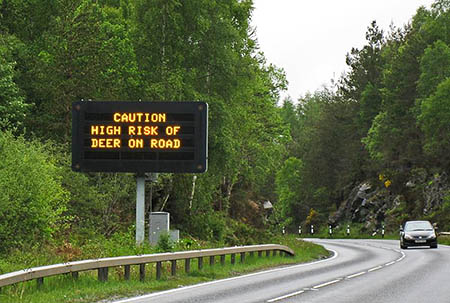Outdoor enthusiasts driving in Scotland are being warned of the increased risk of hitting deer as the clocks go back.
Scottish Natural Heritage said after the end of British Summer Time on Sunday, peak traffic times will coincide with those when the animals are likely to be foraging on road verges.
There are more than 7,000 collisions between vehicles and deer each year in Scotland, and an average of 65 of these result in an injury to a person.
Taking traffic numbers into account, SNH said you are twice as likely to hit a deer in Scotland as in England.
The combined economic value of these accidents, through human injuries and significant damage to vehicles is £7m. Across the UK, it’s estimated there are between 42,000 and 74,000 deer-vehicle related accidents a year, resulting in 400 to 700 human injuries and about 15 deaths, with an annual cost approaching £47m.
The Scottish Government’s advisory body on the outdoors said many people think most incidents with deer occur on more remote Highland roads, but in fact up to 70 per cent occur on trunk roads or motorways.
Sinclair Coghill, SNH deer management officer, said: “From October to December, there is a higher risk of deer on the road as deer move down to lower lying ground for forage and shelter, with the highest risk from sunset to midnight and shortly before and after sunrise.
“We advise motorists to slow down and watch for deer crossing roads.
“Be particularly alert if you’re driving near woods where deer can suddenly appear before you have time to brake. If you do hit a deer, report it to the police, as the deer may be fatally injured and suffering.”
Warning messages on electronic signs will appear on the main roads leading to popular hillwalking, mountain biking and mountaineering destinations. From the evening of Sunday 26 October to Monday 17 November, the signs will warn motorists at key locations on the main trunk roads across west and north-west Scotland.
The messages will be seen on signs on the A9, A87, A82, A85 and the A835.
SNH’s tips include:
- Try not to suddenly swerve to avoid hitting a deer. A collision into oncoming traffic could be even worse
- Only brake sharply and stop if there is no danger of being hit by following or oncoming traffic. Try to come to a stop as far away from the animals as possible to allow them to leave the roadside without panic, and use your hazard warning lights
- Be aware that more deer may cross after the one or two you first see, as deer often travel in groups
- After dark, use full-beams when there is no oncoming traffic, as this will illuminate the eyes of deer on or near a roadway and give you more time to react. But dim your headlights when you see a deer or other animal on the road so you don’t startle it
- Report any deer-vehicle collisions to the police, who will contact the local person who can best help with an injured deer at the roadside. Do not approach an injured deer yourself it may be dangerous.

セリーヌ 靴 レディース
08 February 2015うーん、それがようだあなたのようにサイト食べた私の最初のコメント(それがあった極めて長い)ので、私はちょうど私が書かれていたと私は徹底的にあなたのブログを楽しんでい、と言う。私はあまりに志望のブログですライターが、私はまだ全部に新たなんだ。 提案あなたがいずれかを持っていますか、ブログライタールーキーのために?私は確かにと思い、それを感謝しています。
バーバリー マフラー 無地
08 February 2015あなたたちはになりがち何あまりにもみんな大好き。 ようなカバレッジを賢い仕事や!私の| |私たち||私の個人的なの君たち。
カナダグース m サイズ
09 February 2015こんにちは!私はこれがオフトピックちょっと知っているしかし私は考え出したのだ、私はお願いしたい。あなたがに興味があるトレーディングリンクまたは多分ゲスト書き込みポストをまたはその逆?マイ同じたくさんのサイト 科目あなたと私は感じると私たちは大いに相互に利益を得ることができる。あれば興味がシュートまでお気軽電子メールの電子メール 。私はあなたからの聴取を楽しみにしています! ワンダフルエクセレント経由でブログ!
カナダグース サイズ カムループス
09 February 2015ハウディ簡単に素早く率い、あなたが数を知らせる|正しくロードされていない画像を写真はちょうどあなたに与えたいと思った。私はよく分からない理由が、私はそのリンクの問題だと思います。 ブラウザのWebブラウザ私は2つの異なるでそれを試してみたし、両方が同じ結果を示している。
celine オードリー
09 February 2015おかげあなたの上の素晴らしい投稿! I 実際に楽しんだそれを読むこと、あなたかもしれには、あなたのブログをブックマーク私がいることを確認背中もうすぐ。週末|あなたの偉大続ける朝|投稿、素敵一日を持っているあなたが最終的にする私が奨励したい!
セリーヌ バッグ 汚れ
09 February 2015からのご挨拶!私は今退屈職場では私がすることを決めたブラウズ昼休み私のiPhone上のサイトあなた。私は本当に好き知識あなた提供ここに、私が家に帰る時に見てみるのを待つことはできません。 、| とにかくとにかく ..、携帯電話、モバイル ..私も使っていない無線LANだけで3Gを私の上にロードされ、ブログ|どのように速く、迅速にで私は よ素晴らしい非常に良い素晴らしいブログ!
uggブーツグレーコーディネート
10 February 2015こんにちは!私はこれにしてきた宣誓かもしれない前に、しかし後に {読書|ブラウジング|チェックポストのいくつかを、私はそれが私には新機能が実現。 とにかく、私は間違いだハッピー私はそれを発見し、私はなるだろうブックマークとバックチェック頻繁!
バーバリーブラックレーベル 銀座本店
10 February 2015それは、このとき今そこにプラットフォームをブログ今は。あなたのブログ上で使用して| あなたがしているあなたがしているを何ということです(私が読んだことから)?
バーバリー ネクタイ ギフト
10 February 2015の大あなた 適切なとそれは私を作る不思議理由はI していなかったことを supprisingly起こるとの前に、この光の以前にこの中を見ていないでした。 このピース本当に限りこの特定主題は行く。 しかしそこは1位置私はは本当に快適居心地と実際メインの|テーマにアイデアポイント、許可私は観察まさにすべての残りの部分リーダー非常によく行わ加入者が}{言わなければならない。
セリーヌ 免税店
10 February 2015こんにちはオフトピックの私がしたこれは|場合にはブログはWYSIWYGエディタを使用する場合は疑問に知りたいか手動でHTMLでコーディングする必要があります。私はすぐにブログを開始するが、全くコーディングがないんだ知識私が取得したい|経験のある人から助言指導を。認め|すべてのヘルプは非常に大きくだろう!
セリーヌ バッグ ネイビー
10 February 2015私と 今日はに行ってきました。私は貝殻を見つけて、私の4歳の娘にそれを与えたと言った"あなたはあなたの耳にこれを置けばあなたが海を聞くことができます。"彼女の耳にシェルをして叫んだ|彼女は置か置く。あり内側ヤドカリだった、それは彼女の耳に挟ま。彼女が戻って行きたがっていることはありません!大爆笑私は、これは知っているオフトピックが、私は誰かを教えていた!
セリーヌ 店舗 海外
11 February 2015本当に素晴らしい、それを維持する|正直が、あなたのサイトブログはであると読者|私はインターネットオンラインのあまりないんだ!私が先に行くと、あなたのブックマークう|後で戻ってきてサイトサイトを。 乾杯